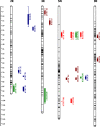QTL mapping of winter dormancy and associated traits in two switchgrass pseudo-F1 populations: lowland x lowland and lowland x upland
- PMID: 33256587
- PMCID: PMC7708163
- DOI: 10.1186/s12870-020-02714-8
QTL mapping of winter dormancy and associated traits in two switchgrass pseudo-F1 populations: lowland x lowland and lowland x upland
Abstract
Background: Switchgrass (Panicum virgatum) undergoes winter dormancy by sensing photoperiod and temperature changes. It transitions to winter dormancy in early fall following at the end of reproduction and exits dormancy in the spring. The duration of the growing season affects the accumulation of biomass and yield. In this study, we conducted QTL mapping of winter dormancy measured by fall regrowth height (FRH) and normalized difference vegetation index (NDVI), spring emergence (SE), and flowering date (FD) in two bi-parental pseudo-F1 populations derived from crosses between the lowland AP13 with the lowland B6 (AB) with 285 progenies, and the lowland B6 with the upland VS16 (BV) with 227 progenies.
Results: We identified 18 QTLs for FRH, 18 QTLs for NDVI, 21 QTLs for SE, and 30 QTLs for FD. The percent variance explained by these QTLs ranged between 4.21-23.27% for FRH, 4.47-24.06% for NDVI, 4.35-32.77% for SE, and 4.61-29.74% for FD. A higher number of QTL was discovered in the BV population, suggesting more variants in the lowland x upland population contributing to the expression of seasonal dormancy underlying traits. We identified 9 regions of colocalized QTL with possible pleiotropic gene action. The positive correlation between FRH or NDVI with dry biomass weight suggests that winter dormancy duration could affect switchgrass biomass yield. The medium to high heritability levels of FRH (0.55-0.64 H2) and NDVI (0.30-0.61 H2) implies the possibility of using the traits for indirect selection for biomass yield.
Conclusion: Markers found within the significant QTL interval can serve as genomic resources for breeding non-dormant and semi-dormant switchgrass cultivars for the southern regions, where growers can benefit from the longer production season.
Keywords: Flowering date; QTL mapping; Spring emergence; Switchgrass; Winter dormancy.
Conflict of interest statement
The authors declare no competing interests.
Figures






Similar articles
-
Genotyping-by-Sequencing and QTL Mapping of Biomass Yield in Two Switchgrass F1 Populations (Lowland x Coastal and Coastal x Upland).Front Plant Sci. 2022 May 19;13:739133. doi: 10.3389/fpls.2022.739133. eCollection 2022. Front Plant Sci. 2022. PMID: 35665173 Free PMC article.
-
Quantitative trait locus mapping combined with variant and transcriptome analyses identifies a cluster of gene candidates underlying the variation in leaf wax between upland and lowland switchgrass ecotypes.Theor Appl Genet. 2021 Jul;134(7):1957-1975. doi: 10.1007/s00122-021-03798-y. Epub 2021 Mar 24. Theor Appl Genet. 2021. PMID: 33760937 Free PMC article.
-
Environmentally responsive QTL controlling surface wax load in switchgrass.Theor Appl Genet. 2020 Nov;133(11):3119-3137. doi: 10.1007/s00122-020-03659-0. Epub 2020 Aug 14. Theor Appl Genet. 2020. PMID: 32803378
-
Quantitative Trait Locus Mapping for Flowering Time in a Lowland × Upland Switchgrass Pseudo-F2 Population.Plant Genome. 2018 Jul;11(2). doi: 10.3835/plantgenome2017.10.0093. Plant Genome. 2018. PMID: 30025023
-
Long-term productivity of lowland and upland switchgrass cytotypes as affected by cutting frequency.Bioresour Technol. 2008 Nov;99(16):7425-32. doi: 10.1016/j.biortech.2008.02.034. Epub 2008 Apr 2. Bioresour Technol. 2008. PMID: 18387801 Review.
Cited by
-
Breeding for reduced seed dormancy to domesticate new grass species.Genet Mol Biol. 2024 Apr 12;47Suppl 1(Suppl 1):e20230262. doi: 10.1590/1678-4685-GMB-2023-0262. eCollection 2024. Genet Mol Biol. 2024. PMID: 38666746 Free PMC article.
-
Identification of QTL Associated with Regrowth Vigor Using the Nested Association Mapping Population in Switchgrass.Plants (Basel). 2022 Feb 21;11(4):566. doi: 10.3390/plants11040566. Plants (Basel). 2022. PMID: 35214899 Free PMC article.
-
Multispectral Phenotyping and Genetic Analyses of Spring Appearance in Greening Plant, Phedimus spp.Plant Phenomics. 2023 Jun 26;5:0063. doi: 10.34133/plantphenomics.0063. eCollection 2023. Plant Phenomics. 2023. PMID: 37383728 Free PMC article.
References
-
- Casler MD. Switchgrass breeding, genetics, and genomics. In: Monti A, editor. Switchgrass. Green energy and technology. London: Springer; 2012. pp. 29–53.
-
- Martinez-Reyna JM, Vogel KP. Incompatibility systems in switchgrass. Crop Sci. 2002;42:1800–1805. doi: 10.2135/cropsci2002.1800. - DOI
-
- Zhang Y, Zalapa J, Jakubowski AR, Price DL, Acharya A, Wei Y, Brummer EC, Kaeppler SM, Casler MD. Natural hybrids and gene flow between upland and lowland Switchgrass. Crop Sci. 2011;51:2626–2641. doi: 10.2135/cropsci2011.02.0104. - DOI
-
- Kszos LA, Downing ME, Wright LL, Cushman JH, McLaughlin SB, Tolbert VR, Tuskan GA, Walsh ME. Bioenergy Feedstock Development Program Status Report. Oak Ridge National Laboratory. 2000.
-
- Parrish DJ, Fike JH. The biology and agronomy of switchgrass for biofuels. Crit Rev Plant Sci. 2005;24:423–459. doi: 10.1080/07352680500316433. - DOI
MeSH terms
LinkOut - more resources
Full Text Sources

